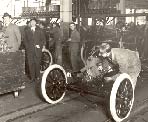
The Degradation of Work Revisited: Workers and Technology in the American Auto Industry, 1900-2000
Introduction
The industrial technology of the American automobile industry had its origins in the American System of Manufactures that evolved through the second half of the nineteenth century. In many ways, the new mass production technology that evolved in the Ford Highland Park plant from 1908 through 1913 represented a culmination of this unfolding technical system. As the sociologist Ely Chinoy noted, the Ford Assembly line “has been a dominating symbol of modern industrialism.” The new automotive production technology was indeed the dominant industrial technology for most of the twentieth century. As Peter Drucker proclaimed: “The automobile industry stands for modern industry all over the globe. It is to the twentieth century what the Lancashire cotton mills were to the nineteenth century: the industry of industries.”
As the twentieth century’s “industry of industries,” the American automobile industry dramatically transformed the nature, the character, and the shape of work for the modern world. When it first emerged at the dawn of the new century, the manufacture of automobiles rested on a craft system of production utilizing the discreet and complicated skills of craft workers from Detroit’s foundries, machine shops, and carriage-making shops. As the Ford Motor Company struggled to meet the huge popular demand for what Henry Ford called his “motorcar for the great multitude,” the Model T, industrial managers and engineers rearranged and transformed how automobiles were manufactured and how auto workers labored. Instead of requiring the highly refined mental and manual skills of the craft worker, the new industrial processes called for simple tasks repeatedly done over and over again. The result was what some have labeled “the degradation of work.” To be sure, new methods, new materials, and new technologies at times reshaped and at times eliminated some of the more onerous and arduous work tasks. Yet, despite numerous and varied technological advances, work became generally more monotonous and more degrading for countless auto workers.
For American automobile workers, one relatively constant feature of their daily factory lives was this simplified, monotonous, and degraded work. Although work tasks, work situations, and work routines varied considerably from automobile firm to automobile firm and from one shop or department to another, the work tasks of assembly line workers were the simplest, most boring, and most degrading. As Chinoy observed in the 1960s, while a small proportion, no more than 18%, of auto workers were classified as assemblers, many other auto factory jobs, such as “paint sprayers, polishers, welders, upholsterers,” and others, “have been subject to the same kinds of job experiences as those engaged in assembly.” And, many, many others worked at machines whose rhythms and cycles shaped and determined their specific work tasks and work pace.
<<Previous Section - Next Section>>
Introduction
Labor under Mass Production: Ford and the Five Dollar Day
More of the Same: The Rise of Sloanism and Flexible Mass Production
Men at Work? Masculinity and Mass Production in the 1920s and 1930s
The Rise of the Unions and the Effects of World War II
Labor and the Post-War Automation Movement
The “Blue Collar Blues” of the 1970s
About the Project | Credits | Contact Us | Student & Teacher Resources | Site Map
©2004 Automobile in American Life and Society


